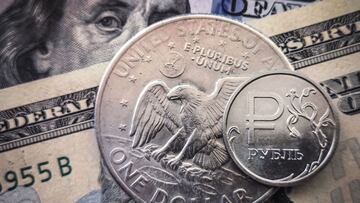Why can't Russia pay its bonds in Russian currency?
A key test of whether or not Russia would default on its foreign debt came on Wednesday when government bond holders were issued payment in dollars.

Since Russia invaded Ukraine, the US and its allies have imposed crippling sanctions on Russian the likes of which have never been seen. With the freezing of Russia’s central bank assets, the nation’s currency, the ruble, has plummeted in value.
Interest payments on $117 million in dollar-denominated government debt came due on 16 March. Although the Russian finance ministry said the payment would be made in dollars there were doubts. A source told the Washington Post that JPMorgan Chase had acted as the intermediary or “correspondent” bank between the investors and Moscow.
Also see:
- What if Russia does not pay its bonds on time?
- The Russian people will pay a high price for the invasion of Ukraine
- What are the key dates for Russia to pay its state bonds?
- What did Arnold Schwarzenegger say about the Russian invasion of Ukraine?
- Thousands of foreign fighters have landed in Ukraine creating a complex tapestry of soldiers
Russian government says that it could pay debt obligations in rubles
Russian Finance Minister Anton Siluanov has said that his nation will honor its financial obligations, but that if sanctions on Russia prevent payment in dollars or euros, the national currency, the ruble, will be used instead. Technically, Russia can service its debts and pay creditors in dollars until midnight 25 May a US Treasury Department spokesperson told Bloomberg.
However, it’s thought that Russia will try to hold on to as much of its remaining foreign currency stockpile that it built up in preparation for sanctions as it can to prop up the ruble. Nearly half of the $640 billion currency reserves Russia stowed away have been frozen in countries that have placed crushing sanctions on the Kremlin in response to the invasion of Ukraine. Those sanctions have tanked the ruble which over the past month has lost 30 percent of its value against the US dollar.
Paying debts in alternate currency is basically a default
The failure to cover the interest payments in dollars would not have immediately triggered a default on the outstanding debt by the Russian government. That sovereign debt default could have come as soon as 15 April, once the 30-day grace period had expired. If the Russian government paid in rubles, that would have constituted a default if not corrected by the end of the grace period.
The last time Russia defaulted on a foreign-currency debt was in 1918 when the Bolshevik Party refused to repay investors on all prior bonds issued by the Tsars or the Russian government.
Russia has a series of payments coming due
The Russian government needs to make payments on over $700 million worth of government bonds this month. In total the Russian government owes around $40 billion in US dollar- and euro-denominated debt, half of that debt is held by foreign investors.
Another estimated $100 billion in foreign currency debt is owed by Russian corporations with around a fifth held by foreign investors. Should Russia default those investors will have an arduous path through the courts to try to reclaim their money. Not until 1986 did the Soviet Union agree to settle at least some of the claims for the Tsarist-era debt.






